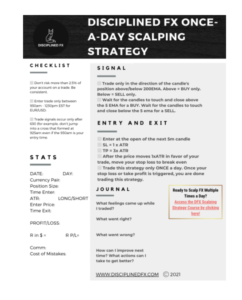
How to Keep a Forex Trading Journal
Why You Should Keep a Trading Journal
The reason why I chose the name disciplined FX is because this is the trading skill that leads all other trading skills. If you can’t follow your strategy’s rules, it doesn’t matter if it’s a winning strategy. If you change your mind a lot about what you see or what you’re going to do when you perform technical analysis, it doesn’t matter if you know how to use every single indicator or naked candle set up.
You only have a strategy and a system if you can perform it day in and day out in front of the charts.
So when we talk about discipline, we’re not referring to some kind of mean mindset where you have to mentally force yourself to act rigidly and never enjoy life. Instead we’re talking about discipline as the ability to understand the outcomes of your actions and be willing to stick with the behaviors that lead to long-term rewards instead of short-term ones that prioritize comfort or let your emotions run the show.
In this way, discipline is a habit we develop – a habit anyone can develop if you can stick with new behaviors long enough to rewire your brain and break that point at which you no longer need to force yourself to perform the behavior.
Instead, this behavior now happens almost automatically.
So to summarize, discipline is about knowing the long-term outcomes of certain behaviors and then choosing to stick with the positive behaviors long enough to let them become habits.
Now one of the most important habits you can do to develop yourself as a trader and improve your ability to follow your trading rules is to keep a trading journal.
Most people think of a trading journal as merely recording the data about your trades, such as what was the price of entry, what was the price of exit, how much you made or lost, and other statistics.
While this information is important and highly beneficial for tracking, your trading journal needs to be more than that in order to get the most out of the habit.
Most brokerage firms provide these stats for you, but the art of tracking our progress isn’t about just collecting our numbers. We need to know what we were thinking about during the trade. If we make mistakes, we need to know what happened in order to avoid making the same mistake again. Thus, when you keep a trading journal that not only covers the stats of the trade but also includes information about what you were feeling and whether you followed your rules or not, you create a resource you can come back to and reflect upon, so that you can turn your experience into articulated lessons.
Today, I’m going to show you how to make a forex trading journal that does precisely that.
Forex Trading Journal Basics
Okay, here are a few things you need to include at a minimum in order to create a journal that’s capable of turning you into a better trader.
1. Include basic stats about your trade. This is like the trade’s ID card.
You’ll want to include the date, day of the week, price of entry, price of exit, time of entering and exiting the trade, as well as how many pips were captured or loss, and your overall profit and loss in your currency.
I also personally like to include the percentage gained or lost and what the risk-reward ratio of the trade was.
 This basic information helps you understand the parameters and outcome of the trade.
This basic information helps you understand the parameters and outcome of the trade.![]()
2. Include a section dedicated to recording your emotions
This is perhaps one of the most important elements of your journal that turns it into something more than just a logbook, is a section dedicated to recording your emotions and actions that you took during the trade.
I like to remind students in the Disciplined FX Scalping Strategy Course that when you record your emotions, you actually need to make sure you’re naming emotions and not just logging what happened play by play.
If you were to write in your forex trading journal that you cut your profit earlier than your planned target, that’s not naming an emotion.
You want to know whether you got out early because you were feeling anxious about the target being too close to a resistance level or because you were afraid this trade was going to turn around and plummet because that’s what happened to you last week.
I’m underscoring the importance of recording your emotions because ultimately the number one thing that’s going to make you break your trading rules is an emotion getting inside your head and tricking you into thinking it’s logic.
If you don’t know what they are or what they feel like, you’re going to get tricked every time.
So your goal is to start recognizing what you’re feeling while you’re feeling it and writing it down in your journal even before it happens.
You could write down the time and say something like “price is moving towards my stop loss and I’m afraid I’m going to miss out before price turns around”. By writing this down, you can stop yourself in the moment and choose to follow your rules instead. In this way, your journal is a tool to help you stick to your discipline.
When you go back later to review your trades for the day or for the week, you can easily reflect on what your biggest emotions you need to watch out for going over the trades you made mistakes and noticing which emotion seems to appear the most.
Can you imagine just how powerful this habit is?
3. Include visual documentation
If you decide to use a free digital journal such as a google doc or even a Trello board, you can take screenshots of a marked up chart, showing where you entered and exited, as well as any other drawings from your trade, which can give you a much clearer idea of what you were looking at when you made your trading decisions.
This step is a must-do if you are a trader who uses candlestick patterns to perform your strategy.
Another visual tool you can use is to create journal sheets with your strategy’s rules already written on them with checkboxes so that you are certain to follow each step of your trade.
This is a particularly useful thing to include if you are like me and you use purely mechanical rules to perform your strategy.
 Here’s an example from the free Disciplined FX 5m scalping strategy. (You can download your own free copy of the pdf by following the link)
Here’s an example from the free Disciplined FX 5m scalping strategy. (You can download your own free copy of the pdf by following the link)
There are definitely other things you can add to your journal depending on your personality as a trader and the strategies you use.
However, please remember that your journal is only as effective as you are willing to make it a habit in your trading routine.
It’s also important to make time to regularly review your journal, such as every night or on a Saturday evening before your next trading week, so that you can turn your experience into lessons that help you put a stop to bad behavior or make better decisions as you trade.
I hope you found this information helpful, be sure to sign up for the Disciplined FX Newsletter to receive more tips and notifications. I wish you all the best of strength and luck, and I’ll see you in the markets. Take care!




I have been surfing online greater than 3 hours nowadays, yet I by no means discovered any attention-grabbing article like yours. It’s beautiful price enough for me. In my view, if all web owners and bloggers made good content material as you probably did, the web will probably be a lot more useful than ever before.
I was suggested this web site by way of my cousin. I’m not positive whether or not this submit is written by way of him as no one else know such targeted about my problem. You’re amazing! Thank you!
Your style is so unique compared to many other people. Thank you for publishing when you have the opportunity,Guess I will just make this bookmarked.2
You actually make it seem really easy with your presentation however I find this matter to be really something that I think I might never understand. It kind of feels too complex and very large for me. I’m having a look ahead on your next publish, I will try to get the cling of it!
I love the efforts you have put in this, appreciate it for all the great articles.
fantastic post.Ne’er knew this, thankyou for letting me know.
What’s Happening i am new to this, I stumbled upon this I’ve discovered It positively useful and it has helped me out loads. I am hoping to give a contribution & aid other customers like its aided me. Great job.
I’m really enjoying the design and layout of your blog. It’s a very easy on the eyes which makes it much more pleasant for me to come here and visit more often. Did you hire out a developer to create your theme? Excellent work!
You have brought up a very great details, regards for the post.
This is very interesting, You’re a very skilled blogger. I’ve joined your feed and look forward to seeking more of your great post. Also, I have shared your website in my social networks!
WONDERFUL Post.thanks for share..more wait .. …
Hello, i believe that i saw you visited my weblog thus i got here to “return the favor”.I’m attempting to find issues to enhance my website!I assume its good enough to make use of some of your ideas!!
I am not real great with English but I line up this real easygoing to interpret.
I like this post, enjoyed this one thankyou for putting up.
Hiya! I know this is kinda off topic however I’d figured I’d ask. Would you be interested in exchanging links or maybe guest authoring a blog post or vice-versa? My website goes over a lot of the same topics as yours and I think we could greatly benefit from each other. If you’re interested feel free to send me an e-mail. I look forward to hearing from you! Great blog by the way!
F*ckin’ remarkable things here. I am very happy to look your post. Thanks so much and i’m having a look ahead to touch you. Will you please drop me a e-mail?
hello there and thank you for your information – I’ve certainly picked up anything new from right here. I did however expertise several technical points using this web site, since I experienced to reload the site many times previous to I could get it to load properly. I had been wondering if your web host is OK? Not that I’m complaining, but sluggish loading instances times will often affect your placement in google and can damage your high quality score if advertising and marketing with Adwords. Anyway I am adding this RSS to my email and could look out for a lot more of your respective exciting content. Make sure you update this again soon..
In the grand pattern of things you’ll get a B+ for effort. Exactly where you actually misplaced us ended up being in your particulars. You know, as the maxim goes, details make or break the argument.. And it couldn’t be more true right here. Having said that, allow me tell you what exactly did do the job. Your authoring is certainly extremely persuasive which is probably the reason why I am making the effort to opine. I do not make it a regular habit of doing that. Next, although I can easily notice the leaps in reason you come up with, I am definitely not sure of exactly how you appear to connect your ideas which produce the conclusion. For now I shall subscribe to your position however trust in the foreseeable future you actually connect your dots better.
As I website owner I believe the articles here is real great, appreciate it for your efforts.
Hi there, You have done a fantastic job. I’ll certainly digg it and personally recommend to my friends. I’m sure they’ll be benefited from this website.
You can certainly see your enthusiasm in the paintings you write. The world hopes for even more passionate writers like you who are not afraid to mention how they believe. All the time follow your heart.
I like the helpful information you provide in your articles. I will bookmark your weblog and check again here regularly. I am quite sure I will learn a lot of new stuff right here! Good luck for the next!
Hello there, I found your web site via Google while looking for a related topic, your website came up, it looks good. I have bookmarked it in my google bookmarks.
I have recently started a blog, the information you offer on this site has helped me tremendously. Thanks for all of your time & work.
Good web site! I truly love how it is easy on my eyes and the data are well written. I am wondering how I could be notified whenever a new post has been made. I’ve subscribed to your feed which must do the trick! Have a nice day!
I carry on listening to the news bulletin speak about receiving boundless online grant applications so I have been looking around for the finest site to get one. Could you tell me please, where could i get some?
I have recently started a website, the information you offer on this site has helped me tremendously. Thanks for all of your time & work.
About GlucoTrust. GlucoTrust is a natural supplement that promotes normal blood sugar levels.
Excellent goods from you, man. I’ve understand your stuff previous to and you’re just extremely magnificent. I really like what you have acquired here, really like what you’re stating and the way in which you say it. You make it enjoyable and you still take care of to keep it wise. I can’t wait to read much more from you. This is really a great website.
I like what you guys are up too. Such clever work and reporting! Carry on the superb works guys I’ve incorporated you guys to my blogroll. I think it will improve the value of my web site :).
Yesterday, while I was at work, my sister stole my apple ipad and tested to see if it can survive a forty foot drop, just so she can be a youtube sensation. My iPad is now broken and she has 83 views. I know this is completely off topic but I had to share it with someone!
I cling on to listening to the news speak about getting free online grant applications so I have been looking around for the finest site to get one. Could you tell me please, where could i find some?
Yay google is my queen assisted me to find this great site! .
Thanks for sharing excellent informations. Your site is very cool. I’m impressed by the details that you have on this website. It reveals how nicely you understand this subject. Bookmarked this website page, will come back for more articles. You, my pal, ROCK! I found simply the info I already searched all over the place and simply could not come across. What a great web site.
Hey There. I discovered your weblog the use of msn. That is a really smartly written article. I will make sure to bookmark it and return to learn more of your useful info. Thank you for the post. I’ll definitely return.
I regard something genuinely interesting about your blog so I saved to my bookmarks.
I like this web site very much so much fantastic information.
Very well written article. It will be beneficial to anyone who employess it, including yours truly :). Keep doing what you are doing – i will definitely read more posts.
I dugg some of you post as I thought they were very useful extremely helpful
Hello, i believe that i saw you visited my website thus i got here to “go back the desire”.I’m attempting to in finding things to enhance my web site!I assume its adequate to use some of your ideas!!
Hey! I just want to give an enormous thumbs up for the great info you have got right here on this post. I can be coming back to your weblog for more soon.
Simply a smiling visitant here to share the love (:, btw outstanding style and design. “Justice is always violent to the party offending, for every man is innocent in his own eyes.” by Daniel Defoe.
What Is Wealth Signal? the Wealth Signal isn’t just a financial tool; it’s a new way of thinking about and achieving wealth. Unlike traditional methods that focus on external strategies, Wealth Signal emphasizes changing your internal mindset.
What Is ZenCortex? ZenCortex is a natural supplement that promotes healthy hearing and mental tranquility. It’s crafted from premium-quality natural ingredients, each selected for its ability to combat oxidative stress and enhance the function of your auditory system and overall well-being.
I’ve been surfing online more than three hours nowadays, but I by no means found any interesting article like yours. It’s lovely worth enough for me. In my view, if all web owners and bloggers made just right content material as you probably did, the web will likely be much more helpful than ever before.
Very well written article. It will be beneficial to anybody who usess it, as well as myself. Keep doing what you are doing – i will definitely read more posts.
You actually make it seem so easy along with your presentation but I to find this matter to be really one thing that I believe I would never understand. It sort of feels too complex and extremely wide for me. I am looking forward to your subsequent submit, I will attempt to get the hold of it!
I got what you mean , appreciate it for posting.Woh I am thankful to find this website through google. “Spare no expense to make everything as economical as possible.” by Samuel Goldwyn.
Everything is very open and very clear explanation of issues. was truly information. Your website is very useful. Thanks for sharing.
You are my aspiration, I possess few web logs and often run out from to post .
When I originally commented I clicked the -Notify me when new comments are added- checkbox and now each time a comment is added I get four emails with the same comment. Is there any way you can remove me from that service? Thanks!
Some genuinely wonderful work on behalf of the owner of this internet site, utterly outstanding subject material.
Lovely site! I am loving it!! Will come back again. I am bookmarking your feeds also
Pingback: Kimber Firearms
Enjoyed studying this, very good stuff, regards. “Be not careless in deeds, nor confused in words, nor rambling in thought.” by Marcus Aurelius Antoninus.
of course like your web-site but you have to check the spelling on several of your posts. A number of them are rife with spelling problems and I find it very bothersome to tell the truth nevertheless I will surely come back again.
Greetings! This is my first visit to your blog! We are a collection of volunteers and starting a new project in a community in the same niche. Your blog provided us beneficial information to work on. You have done a marvellous job!
Excellent post. I was checking continuously this blog and I’m impressed! Extremely useful information particularly the last part 🙂 I care for such info much. I was looking for this certain information for a long time. Thank you and good luck.
Keep up the excellent piece of work, I read few articles on this web site and I think that your web blog is really interesting and has lots of fantastic info .
Good day! This is my first visit to your blog!We are a group of volunteers and starting a new initiativein a community in the same niche Your blog provided us valuable information to work on You have done a wonderful job!
I adore meeting useful info, this post has got me even more info! .
Wow that was strange. I just wrote an really long comment but after I clicked submit my comment didn’t show up. Grrrr… well I’m not writing all that over again. Anyway, just wanted to say wonderful blog!
I’m not sure where you’re getting your info, but great topic. I needs to spend some time learning much more or understanding more. Thanks for fantastic info I was looking for this information for my mission.
I love it when people come together and share opinions, great blog, keep it up.
You rocked this subject and have astounding insights. I also work hard in putting together great content about Cosmetics, feel free to visit FQ6
I couldn’t resist commenting
Good – I should definitely pronounce, impressed with your site. I had no trouble navigating through all the tabs and related information ended up being truly simple to do to access. I recently found what I hoped for before you know it at all. Quite unusual. Is likely to appreciate it for those who add forums or anything, site theme . a tones way for your client to communicate. Excellent task.
great post, very informative. I’m wondering why the other specialists of this sector do not notice this. You should continue your writing. I’m confident, you have a huge readers’ base already!
Very interesting info !Perfect just what I was searching for! “One man’s folly is another man’s wife.” by Helen Rowland.
A powerful share, I simply given this onto a colleague who was doing a bit analysis on this. And he in truth bought me breakfast because I discovered it for him.. smile. So let me reword that: Thnx for the deal with! But yeah Thnkx for spending the time to debate this, I really feel strongly about it and love studying extra on this topic. If possible, as you develop into experience, would you thoughts updating your weblog with extra details? It is highly helpful for me. Big thumb up for this weblog publish!
Yeah bookmaking this wasn’t a bad determination great post! .
I have been exploring for a little bit for any high quality articles or blog posts in this kind of house . Exploring in Yahoo I eventually stumbled upon this website. Reading this info So i¦m glad to convey that I’ve an incredibly just right uncanny feeling I came upon just what I needed. I so much certainly will make sure to do not disregard this website and provides it a look regularly.